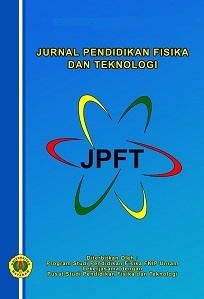Virtual Experiment Untuk Meningkatkan Pemahaman Siswa Pada Konsep Getaran Dan Gelombang
DOI:
10.29303/jpft.v5i1.1141Published:
2019-06-01Issue:
Vol. 5 No. 1 (2019): Januari - JuniKeywords:
Virtual Experiment, Concepts Understanding, Vibration And Waves ConceptsArticles
Downloads
Additional Files
How to Cite
Downloads
Metrics
Abstract
The experimental activities in physics learning are intended to build students' understanding of the concepts of physics. The limitations of experimental equipment have an impact on the low understanding of students' physics concepts. Virtual media can be used as an alternative experimental tool to improve students' conceptual understanding. This study aims to examine the effectiveness of virtual experiments in increasing students' understanding of the concepts of vibration and waves. Quasi-experimental research was conducted using the pretest and posttest control group design. The number of respondents was 40 students who were divided into the experimental group and the control group. The research data were analyzed by N-gain test to determine the level of increase in mastery of concepts using virtual experiments that have been used. The results showed that the achievement level of the experimental group was better than the control group. It can be concluded that virtual experiments are effective in increasing the understanding of students' physics concepts.References
Diana, N., Walidain, S. N., & Rahman, A. H. 2018. Integrasi Learning Management System (LMS) dan Simulasi PhET pada Pembelajaran Fisika Terhadap Keterampilan Proses Sains. QUARK: Jurnal Inovasi Pembelajaran Fisika Dan Teknologi, 1(1), 36-40.
Gunawan, G., Harjono, A., Sahidu, H., & Herayanti, L. 2017. Virtual Laboratory of Electricity Concept to Improve Prospective Physics Teachers Creativity. Jurnal Pendidikan Fisika Indonesia, 13(2), 102-111.
Gunawan, Nisrina, N., Suranti, N. M. Y., Herayanti, L., & Rahmatiah, R. 2018a. Virtual Laboratory to Improve Studentsââ¬â¢ Conceptual Understanding in Physics Learning. Journal of Physics: Conference Series. 1108 (1) p. 012049.
Gunawan, Suranti, N. M. Y., Nisrina, N., Herayanti, L., & Rahmatiah, R. 2018b. The effect of virtual lab and gender toward studentsââ¬â¢ creativity of physics in senior high school. In Journal of Physics: Conference Series 1108 (1) p. 012043.
Gunawan, Harjono, A., Sahidu, H., & Nisrina, N. 2018c. Improving studentsââ¬â¢ creativity using cooperative learning with virtual media on static fluida concept. Journal of Physics: Conference Series, 1006 (1), 012016.
Hake R 1999 Analyzing Change/Gain Score (Indiana: Indiana University).
Hermansyah, H., Gunawan, G., & Harjono, A. 2017. Pengaruh Penggunaan Laboratoium Virtual Dalam Pembelajaran Inkuiri Terbimbing Terhadap Penguasaan Konsep Kalor Peserta Didik. Jurnal Pendidikan Fisika dan Teknologi, 3(2), 249-256.
Hermansyah, H., Gunawan, G., & Harjono, A. 2018. The Effect of Using Virtual Laboratory in Guided Inquiry Learning on Cognitive Learning Outcomes of Physics. IOSR Journal of Research & Method in Education (IOSR-JRME), 8(1), 15-20.
Hermansyah, H., Gunawan, & Herayanti, L. 2015. Pengaruh penggunaan laboratorium virtual terhadap penguasaan konsep dan kemampuan berpikir kreatif siswa pada materi getaran dan gelombang. Jurnal Pendidikan Fisika dan Teknologi, 1(2), 97-102.
Hermansyah, H., Gunawan, Harjono, A., & Adawiyah, R. 2019. Guided inquiry model with virtual labs to improve studentsââ¬â¢ understanding on heat concept. Journal of Physics: Conference Series. 1153(1), 012116. IOP Publishing.
Holden J T & Gamor K I. 2010. An Instructional Media Selection Guide for Distance Learning (2nd Ed.) (United States of America: United States Distance Learning Association).
Lala, Z. H. A. O., Chusheng, L. I. U., & Junxia, Y. A. N. 2010. A Virtual Experiment Showing Single Particle Motion on A Linearly Vibrating Screen-Deck. Mining Science and Technology (China), 20(2), 276-280.
Manurung, S., & Rustaman, N. Y. 2010. Hands and minds activity dalam pembelajaran fisika kuantum untuk calon guru. In Prosiding Seminar Nasional Fisika.
Mashami, R. A., & Gunawan. 2018. The Influence of Sub-Microscopic Media Animation on Students' Critical Thinking Skills Based on Gender. In Journal of Physics: Conference Series. 1108 (1) p. 012106.
Sarini, P. 2012. Pengaruh Virtual Experiment Terhadap Hasil Belajar Fisika Ditinjau dari Motivasi Belajar Siswa SMA Negeri 1 Singaraja. Jurnal Pendidikan dan Pembelajaran IPA Indonesia, 2(2).
Sund, R. B., & Trowbridge, L. W. 1973. Teaching science by inquiry in the secondary school. Merrill Publishing Company.
Suparno, P. 1997. Filsafat Konstruktivisme dalam Pendidikan. Yogyakarta: Kanisius.
Tuysuz, C. 2010. The Effect of the Virtual Laboratory on Students' Achievement and Attitude in Chemistry. International Online Journal of Educational Sciences. 2(1), 37-53.
Yahya, F., & Fitriyanto, S. 2018. Pengaruh Model Pembelajaran Berbasis Masalah Berbantuan Simulasi Interaktif Terhadap Keterampilan Generik Sains Siswa SMA Pada Materi Elastisitas. Jurnal Pendidikan Fisika dan Teknologi, 2(3), 136-141.
Author Biographies
Fahmi Yahya, Program Studi Pendidikan Fisika Universitas Samawa
Hermansyah Hermansyah, Program Studi Pendidikan Fisika Universitas Samawa
Syarif Fitriyanto, Program Studi Pendidikan Fisika Universitas Samawa
License
Authors who publish with Jurnal Pendidikan Fisika dan Teknologi (JPFT) agree to the following terms:
- Authors retain copyright and grant the journal right of first publication with the work simultaneously licensed under a Creative Commons Attribution License 4.0 International License (CC-BY-SA License). This license allows authors to use all articles, data sets, graphics, and appendices in data mining applications, search engines, web sites, blogs, and other platforms by providing an appropriate reference. The journal allows the author(s) to hold the copyright without restrictions and will retain publishing rights without restrictions.
- Authors are able to enter into separate, additional contractual arrangements for the non-exclusive distribution of the journal's published version of the work (e.g., post it to an institutional repository or publish it in a book), with an acknowledgement of its initial publication in Jurnal Pendidikan Fisika dan Teknologi (JPFT).
- Authors are permitted and encouraged to post their work online (e.g., in institutional repositories or on their website) prior to and during the submission process, as it can lead to productive exchanges, as well as earlier and greater citation of published work (See The Effect of Open Access).











